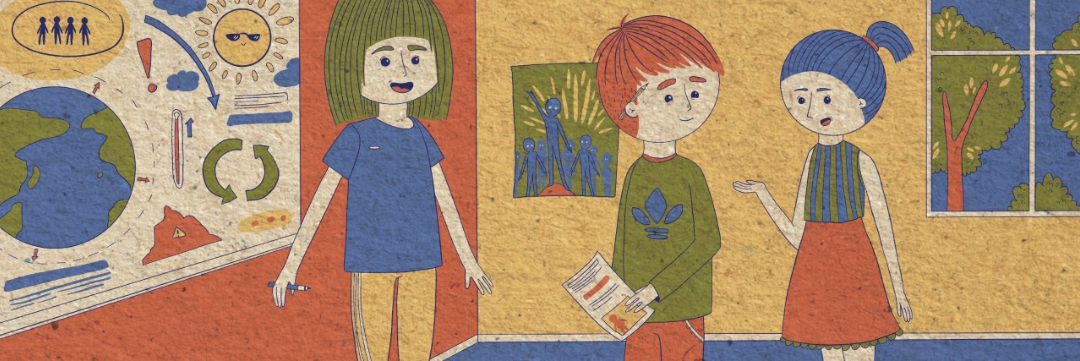Youth work and sustainability
In recent years, climate change has become a relevant issue on the youth work agenda. At a general level, this is corroborated by the results obtained in the 513 Eurobarometer on Climate Change (2021), where 93% of Europeans believe that climate change is a serious problem, with the youth (15-24 years old) being the population group most concerned about this issue. Following this line, a recent study by Siurala (2021) highlights that youth organisations are increasingly including the issue of climate change in their actions.

Alonso Escamilla, University of Salamanca
However, Siurala (2021) himself points out that climate change has not yet become a universally accepted or adopted priority in youth work. The same results are shared by other authors, such as Gorman, Farrelly & Molay (2021), who stress that there are still too many barriers that prevent the inclusion of climate change within youth work due to the tendency to give preference to expert knowledge and to limit the action of youth organisation, youth workers and young people.
After the restoration of independence in 1991, a process of restructuring youth work in Estonia was initiated with the aim of responding to both the needs of an independent state and the requirements of its younger citizens (Taru, 2018). Although in the first decade of independence there were no major developments, everything changed from the approval of the Youth Work Act (Estonian Government, 1999). This statute defined youth work as the “provision of conditions that support the development of young people’s personalities through voluntary participation in activities outside the formal education system”.

Paula Gonzalo, University of Salamanca
Since then, several authors have pointed out how youth work has enabled young people in Estonia to acquire a series of vital competencies for their personal, professional and social development. These include improving academic performance and achievement (Fredriks & Eccles, 2006), becoming more politically and civically active in adulthood (Kirlin, 2003) or building peaceful contexts in their localities (Mattero & Campbell-Patton 2008).
In more recent years, environmental protection (and all of its implications) has been gaining ground within youth work (NYA, 2008). The latter has been motivated, especially, by the sensitivity shown by young people themselves towards climate change as well as the activism that has been carried out through School Strike for Climate (Boulianne, Lalancette & Ilkiw, 2020). In fact, according to Jakučionytė-Skodienė and Liobikienė (2022), Estonia was among the EU countries that recorded the largest changes in concern related to climate change from 2015-2019.
Erasmus+ Programme in the field of youth
The Erasmus+ Programme has emerged as the most important European initiative related to the fields of education, training, sport and youth (between 2014 and 2020). This European initiative aims to achieve the social and professional inclusion of all citizens, with a special focus on young people. In order to achieve the above, European entities can submit their initiatives to the following Key Actions: (1) Mobility of individuals for learning purposes; (2) Cooperation for innovation and exchange of good practices; and (3) Support for policy reform (European Commission, 2020).
The EU assumes that public and social agents of each member country, having first-hand knowledge of their context, are best qualified to develop projects that favour young people (Escamilla & Díaz, 2020). For this reason, the EU provides support, resources and opportunities to European entities, regardless of whether they are public or private, to develop projects within the Erasmus+ Programme.
Focusing on the subject of the present article, the Erasmus+ Programme is likely the most important European initiative in the field of youth work; it therefore seems necessary to identify whether this programme has been used to promote actions related to sustainability and environment. The literature indicates that this European initiative (in general) and the strategic partnerships (in particular) have played a very important role in supporting European cooperation in both youth work and sustainability (Siebel, 2017).
For this article, it has been decided to study the strategic partnerships in the youth field from 2014 to 2020 that were coordinated by Estonian entities. This decision is motivated by two fundamental reasons. First, climate change must be addressed from a multisectoral perspective, where all the actors in the ‘ecosystem’ must act to really achieve a positive impact (Gorman, Farrelly & Molay, 2021). Second, strategic partnerships are precisely the initiatives within the Erasmus+ Programme that make it possible to generate a consortium between actors in society to address a common problem (European Commission, 2020).
Results
This section presents the results obtained from the analysis of the initiatives approved for Estonia within the Strategic Partnerships of the Erasmus+ Programme in the period from 2014 to 2020. First of all, it should be noted that in the youth field, Estonia has a total of 738 approved Erasmus+ projects. Of which, 338 correspond to Key Action 1 (mobilities), 54 to Key Action 2 (strategic partnerships), and 46 to Key Action 3 (youth policies and youth dialogue).
We conducted a documentary analysis using MAXQDA software to categorise and systematise the Information from the 54 strategic partnerships. We downloaded the dataset from the Erasmus+ Results Platform for each project, specifically to determine whether the words ‘climate change’, ‘ecology’, ‘environment’, ‘green’, ‘sustainable’, ‘energy’ and ‘resources’ appeared in the Project Title, Project Summary and Topics.
Only four projects were found to be specifically dedicated to climate change or sustainability (Figure 1). The remaining 50 initiatives were dedicated to other topics, especially youth (Participation, Youth Work, Youth Policy). In other words, only 6% of the Estonian Strategic Partnerships were directly dedicated to the environment (Figure 2).
Figure 1. Number of projects in Estonia dedicated to sustainability, youth and other themes in Erasmus+ Strategic Partnerships between 2014 and 2020
Source: own elaboration.
Figure 2. Percentage of projects in Estonia dedicated to sustainability, youth and other themes in Erasmus+ Strategic Partnerships between 2014 and 2020
Source: own elaboration.
Discussion and Conclusions
Although this article is only exploratory and descriptive, the results seem to indicate that climate change has not been a priority within the strategic partnerships in the field of youth in Estonia. These findings seem to be related to the perceptions gathered in the 513 Eurobarometer on Climate Change (2021), where Estonia is below the EU average on climate change or sustainability issues. For example, just over one in ten respondents in Estonia (14%, compared with the EU average of 18%) consider climate change to be the single most serious problem facing the world. At the same time, more than 53% respondents in Estonia say that they have not personally take any action to fight climate change over the last six months (compared with the EU average of 35%).
As reported by Kessler (2021), Estonia was one of the countries with the greatest percentage of students who believed that climate change was a minor threat or non-threat (on average one-fourth of students). It was also one of the countries with the lowest levels of student engagement in learning about the environment in school. This is because individual characteristics, such as age and socioeconomic status, significantly shape climate change risk perceptions. Thus, they also influence the priorities of young people’s interests and youth worker actions in regard to non-formal participation. For instance, in Estonia, teenagers and people in their twenties are the most brand-oriented consumers and show lower levels of sustainable consumption than the oldest age group (Kalmus et al. 2009).
At the same time, in Estonia, the patterns of sustainable consumption depend on socio-economic factors (such as low access to services and products), ethnic groups or age cohort. The socio-economic situation of a country can shape the kinds of policies, programmes and projects that are implemented as well as define the issues addressed and the objectives pursued (Escamilla, 2020). This context is also closely related to youth work (Coussee et al., 2009), as different situations make the youth work agenda prioritise certain issues over others.
For example, the youth unemployment rate in Estonia, among 15–24-year-olds from 2014 to 2020, has been on a bit of a seesaw. Figure 3 illustrates that from 2014, with 18.9%, the general trend of unemployment among young people has been negative. Yet there are two periods in which the unemployment rate grew: in 2016 it increased from 14.9% to 17.6%, and in 2020 it increased from 9.1% to 9.5% (Eurostat, 2022a). In other words, in a context where there is greater concern for addressing youth unemployment, it seems reasonable that Erasmus+ projects focus on solving these more immediate problems.
Figure 3. Youth unemployment rate among 15–24-year-olds
Source: own elaboration
On the other hand, Estonia presents a high mobility of youth workers in youth centres and a lack of staff with special education (Veigel, 2019). This poses a major obstacle to youth work in terms of the development of young people’s key competences and, most likely, to the ability to focus on such a complex topic as climate change. On top of this, the research done by Veigel (2019) shows that youth workers’ motivation lies mainly in short-term goals and young people’s satisfaction with youth work interventions, which are not dynamics of environmental work. In other words, helping young people accomplish their goals in a short period of time presumably stimulates youth workers more than long-term sustainability projects that may or may not show visible outcomes.
This is also related to the fact that youth work is a wide-ranging concept that comprises diverse variations in practices, goals and environments (Taru et al. 2014). Due to this manifoldness in the options of youth work, it is necessary for each country to establish priorities according to their socioeconomic and historical contexts. In this case, Estonian Strategic Partnerships (and youth work in general) tend to deal with youth social problems as they seem to be more urgent issues, as seen by the NEET rate (Eurostat, 2022b) among 18–29-year-olds (Figure 4).
Figure 4. NEET rate among 18–29-year-olds
Source: own elaboration.
On the other hand, it should be noted that this research only focused on the information available on the Erasmus+ Results Platform. Therefore, it is possible that there are many more projects addressing climate change than those identified in this study. That is, their activities may have been dedicated to sustainability issues even though they may not have made this explicit in their project information. Likewise, only Strategic Partnerships in the field of youth were addressed and not mobility events (youth exchanges and training courses) within this same field. So, we cannot say that the entire youth field in Estonia has not addressed climate change through the Erasmus+ Programme. It is therefore necessary to broaden the spectrum of study in the above two fields to get a more accurate and reliable perspective in order to check whether the Estonian projects within the Erasmus+ Programme in the youth field gave little importance to the environmental issue.
Finally, the new Erasmus+ Programme (2021-2027) is an opportunity for existing youth work structures to renew and modify approaches and working methods on climate change, sustainability and environment. Thus, even though this article shows that there have been few Strategic Partnerships between 2014 and 2020 in Estonia, it does not mean that this situation cannot change in the future. If the youth unemployment and NEET rates decrease and climate change continues to gain urgent relevance, young people’s interests and youth work priorities may change in the future, which would permit a deeper focus on sustainability projects in the new Erasmus+ Programme. This in turn will allow young people to develop their civic skills and create a feeling of self-satisfaction by leaving future generations a healthy ecosystem where they too can evolve personally and professionally.
- Boulianne, S., Lalancette, M. & Ilkiw, D. (2020). School strike 4 climate: social media and the international youth protest on climate change. Media and Communication, 8(2): 208-218.
- Coussée, F., Roets, G. & De Bie, M. (2009) Empowering the powerful: Challenging hidden processes of marginalization in youth work policy and practice in Belgium. Critical Sociology Policy: 421-442. Belgium: Ghent University
- Eesti Vabariigi Valitsus [Estonian Government] (1999). Noorsootöö seadus [Youth Work Act], Tallinn.
- Escamilla, A. (2020). Influencia del contexto socioeconómico en políticas juveniles de la Unión Europea: el programa de Juventud en Acción. Studia Politicae, 51, 107-133.
- Escamilla, A. & Díaz, R. (2020). “Youth policies. The Erasmus+ Programme as a tool to promote European citizenship”. In R. Guzmán and A.B. Grandson ed. Public policies in defense of inclusion, diversity and gender (Edition 2, pp. 653-666). Salamanca: University of Salamanca.
- European Commission. (2020). Erasmus+ Programme Guide. Brussels: European Commission.
- European Commission. (2021). Estonia factsheet on Special Eurobarometer 513. Climate action. Brussels: European Commission.
- Eurostat (2022a). Youth unemployment rate (15-24 years old) – % of active population in the same age [Database]. Recover by https://bit.ly/3SIeymD
- Eurostat (2022b). Youth neither in employment nor in education and training (NEET) rate, age group 15-24 [Database]. Recover by https://bit.ly/3SIeN11
- Fredricks, J. & Eccles, J. (2006). Is Extracurricular Participation Associated with Beneficial Outcomes? Concurrent and Longitudinal Relations, Developmental Psychology 42(4): 698–713.
- Gorman, J., Farrelly, A. & Molay, V. (2021). Facilitating the empowered inclusion of youth in climate policy: A case study of the National Youth Council of Ireland’s future generations – Climate Justice Project. Offenburg Talks No. 4, 7-16. Offenburg: Jugend für Europe.
- Jakučionytė-Skodienė, M., & Liobikienė, G. (2022). The Changes in Climate Change Concern, Responsibility Assumption and Impact on Climate-friendly Behaviour in EU from the Paris Agreement Until 2019. Environmental Management 69, 1–16. https://doi.org/10.1007/s00267-021-01574-8
- Kalmus, V., Keller, M. & Kiisel, M. (2009) Emerging consumer types in a transition culture: Consumption patterns of generational and ethnic groups in Estonia. Journal of Beltic Studies. Vol. 40, No. 1, 53-74.
- Kessler, E. (2021). Climate Change Concern among Youth: Examining the Role of Civics and Institutional Trust across 22 Countries. Vol. 29, No. 124. United States: Education Policy Analysis Archives.
- Kirlin, M. (2003). The Role of Adolescent Extracurricular Activities in Adult Political Participation. CIRCLE Working Paper No. 2. Maryland: Center for Information and Research on Civic Learning and Engagement.
- Mattero, M., & Campbell-Patton, C. (2008). Measuring the impact of youth voluntary service programs. Summary and conclusions of the international expert’s meeting. The World Bank, Innovations in Civic Participation.
- National Youth Agency (2008). The Contribution of Non-Formal Learning to Young People’s Life Chances. Learning from the Evidence. Executive summary. Leicester: National Youth Agency.
- Siebel, C. (2017). Funding sustainable youth work. In Hanjo Schild et al. (eds.), Thinking seriously about youth work. And how to prepare people to do it (pp. 371-377). Brussels: Council of Europe Publishing.
- Siurala, L. (2021). Youth work and climate change. A follow up on the 2019 Finnish Presidency Council debate and questions about the future. Offenburg Talks No. 4, 3-6. Offenburg: Jugend für Europe.
- Taru, M. (2018). Chapter 4: Youth Work in Estonia. In Ord, J. et al. (Eds). The Impact of Youth Work in Europe: A Study of Five European Countries (pp 63-73). Helsinki: Humak University of Applied Sciences Publications.
- Taru, M., Coussée Filip, & Williamson, H. (2014). Youth work in connection to policies and politics. . In The history of youth work in Europe (Vol. 4, pp. 125–136). essay, Council of Europe.
- Veigel, M. (2019). Personality factors as basic elements of the Estonian youth workers´ professional growth. SOCIETY. INTEGRATION. EDUCATION. Proceedings of the International Scientific Conference, No. 5, 292–302.
The cover image was designed by young Estonian artist Luisa Harjak.

